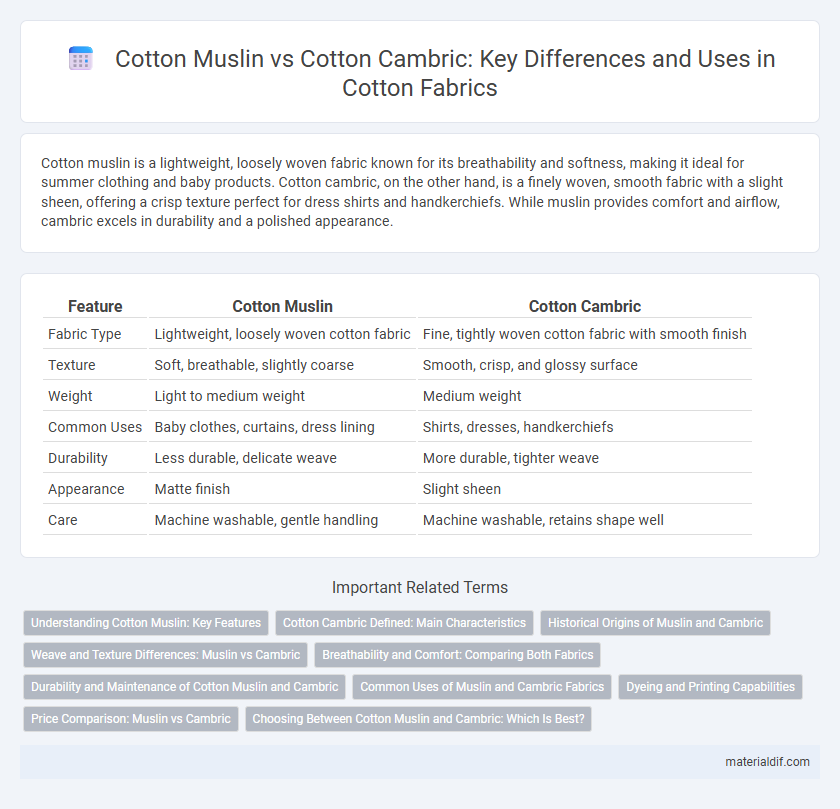Cotton muslin is a lightweight, loosely woven fabric known for its breathability and softness, making it ideal for summer clothing and baby products. Cotton cambric, on the other hand, is a finely woven, smooth fabric with a slight sheen, offering a crisp texture perfect for dress shirts and handkerchiefs. While muslin provides comfort and airflow, cambric excels in durability and a polished appearance.
Table of Comparison
| Feature | Cotton Muslin | Cotton Cambric |
|---|---|---|
| Fabric Type | Lightweight, loosely woven cotton fabric | Fine, tightly woven cotton fabric with smooth finish |
| Texture | Soft, breathable, slightly coarse | Smooth, crisp, and glossy surface |
| Weight | Light to medium weight | Medium weight |
| Common Uses | Baby clothes, curtains, dress lining | Shirts, dresses, handkerchiefs |
| Durability | Less durable, delicate weave | More durable, tighter weave |
| Appearance | Matte finish | Slight sheen |
| Care | Machine washable, gentle handling | Machine washable, retains shape well |
Understanding Cotton Muslin: Key Features
Cotton Muslin is a lightweight, loosely woven fabric known for its breathability and softness, making it ideal for garments and home textiles requiring comfort and airflow. Its open weave structure allows for excellent durability and ease of dyeing, often used in quilting, dressmaking, and medical applications. Compared to Cotton Cambric, Muslin offers a more textured feel and greater versatility in craft and industrial uses due to its natural cotton fibers and flexible weave.
Cotton Cambric Defined: Main Characteristics
Cotton Cambric is a lightweight, fine, and closely woven fabric made from high-quality cotton yarns, renowned for its smooth texture and slightly glossy finish. It offers excellent breathability and durability, making it a preferred choice for summer clothing, handkerchiefs, and fine linings. The fabric's crispness and ability to hold prints well distinguish it from other cotton fabrics like muslin.
Historical Origins of Muslin and Cambric
Cotton muslin traces its origins to ancient Bengal, renowned for its finely woven, lightweight fabric celebrated in Mughal India for its delicate texture and breathability, while cotton cambric originated in 15th-century France as a denser, closely woven fabric prized for its smooth finish and durability. Muslin was historically handwoven on traditional looms, often produced by skilled artisans in regions like Dhaka, whereas cambric evolved with advances in European textile manufacturing techniques, reflecting Renaissance-era innovations. Both fabrics significantly influenced global textile trade, with muslin favored in South Asian climates and cambric extensively used in European fashion and household linens.
Weave and Texture Differences: Muslin vs Cambric
Cotton muslin features a loose, plain weave that creates a soft, breathable fabric with a coarse texture, ideal for lightweight applications and delicate draping. In contrast, cotton cambric has a tight, fine plain weave resulting in a smoother, denser texture with a slight sheen, making it more durable and suitable for shirting and finer garments. The distinct differences in weave density directly impact the tactile feel and visual finish between muslin's airy openness and cambric's crisp smoothness.
Breathability and Comfort: Comparing Both Fabrics
Cotton muslin offers exceptional breathability due to its loosely woven texture, making it ideal for warm climates and sensitive skin. In contrast, cotton cambric features a tighter weave, providing a smoother finish but slightly less airflow, which enhances durability while maintaining moderate comfort. Both fabrics are soft and lightweight, yet muslin excels in ventilation, whereas cambric balances breathability with a polished appearance.
Durability and Maintenance of Cotton Muslin and Cambric
Cotton muslin offers moderate durability with a soft, breathable texture that requires gentle washing to maintain its delicate weave, making it prone to shrinkage and wear over time. Cotton cambric boasts higher durability due to its tighter weave and smooth finish, allowing for more frequent laundering without significant wear or shrinkage. Maintenance of cambric is simpler as it resists wrinkles and retains shape better, while muslin demands careful handling to preserve its lightweight and airy qualities.
Common Uses of Muslin and Cambric Fabrics
Cotton muslin is widely used for lightweight clothing, dressmaking, and home decor items such as curtains and upholstery due to its breathable, soft texture and loosely woven structure. Cotton cambric, characterized by its fine, tightly woven smooth surface, is commonly employed in high-quality shirts, handkerchiefs, and luxurious linings, offering durability and a polished finish. Both fabrics serve different purposes where muslin is favored for comfort and ventilation, while cambric excels in refined apparel and delicate accessory applications.
Dyeing and Printing Capabilities
Cotton Muslin features a loose weave that absorbs dye unevenly, resulting in softer, more muted prints suitable for delicate designs. Cotton Cambric has a tighter weave and smooth surface, allowing for vibrant, sharp dyeing and printing with high color retention. The choice between Muslin and Cambric depends on the desired print clarity and intensity, with Cambric favoring bold patterns and Muslin offering subtle, vintage-style effects.
Price Comparison: Muslin vs Cambric
Cotton muslin is generally more affordable than cotton cambric due to its looser weave and simpler production process, making it a cost-effective choice for lightweight, breathable fabrics. In contrast, cotton cambric, with its tighter weave and smoother finish, commands a higher price point reflective of its durability and finer texture. When comparing prices, muslin suits budget-conscious projects, while cambric is preferred where a polished aesthetic justifies the added expense.
Choosing Between Cotton Muslin and Cambric: Which Is Best?
Cotton muslin offers a soft, breathable texture ideal for lightweight garments and baby clothing, making it perfect for comfort-focused projects. Cotton cambric provides a smoother, denser weave that ensures durability and a polished finish, suitable for shirts and fine dressmaking. Choosing between cotton muslin and cambric depends on the desired fabric weight and end-use, with muslin favored for breathability and cambric for structure and appearance.
Cotton Muslin vs Cotton Cambric Infographic

 materialdif.com
materialdif.com